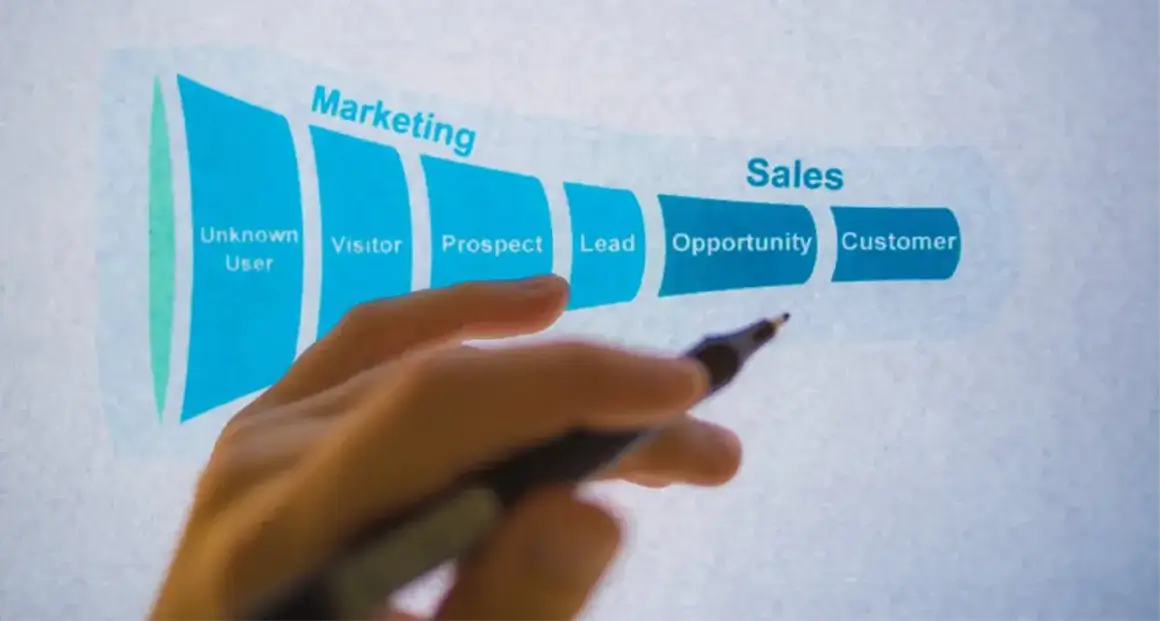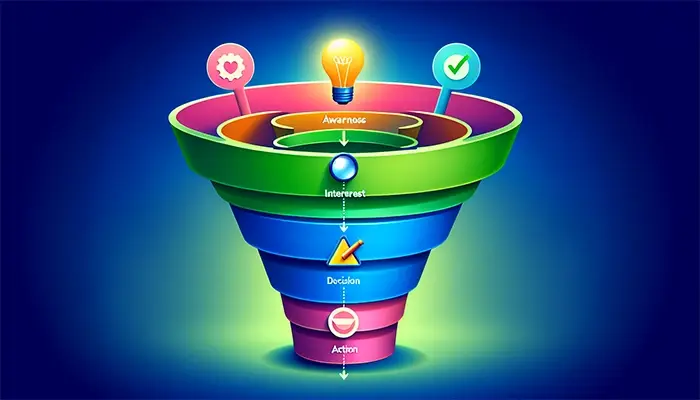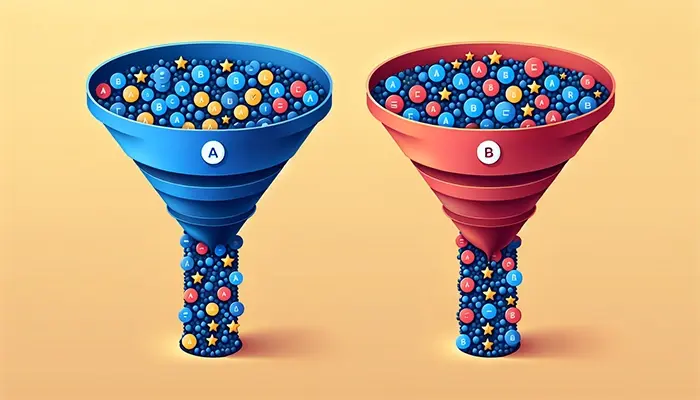
Share
Your Guide to Crafting the Ultimate Affiliate Marketing Funnel
Struggling to convert clicks into commissions? The key is in optimizing your affiliate marketing funnel—a pivotal tool for any marketer aiming to increase profits. This article meticulously details each component of an affiliate marketing funnel, equipping you with strategies to select the best products, engage and convert leads, and analyze performance for continuous improvement. Navigate through our expert advice, skip the guesswork, and start refining your funnel to drive the sales results you’ve been targeting.
Key Takeaways
- Understanding and implementing the AIDA model in an affiliate marketing funnel increases customer engagement and conversion rates.
- Selecting the right affiliate products and marketplace is crucial; focus on quality, reputation, and match with your niche to maximize earnings.
- Optimizing and scaling your affiliate marketing sales funnel involves continuous A/B testing, analyzing KPIs, and diversifying traffic sources for sustained growth.
Understanding the Affiliate Marketing Funnel

An affiliate marketing sales funnel is a strategic model that guides your potential customer, or lead, through their buyer’s journey. From their initial awareness of the product or service to making the final purchase, each stage of the affiliate sales funnel serves a specific purpose in creating a successful sales funnel.
Extending your reach beyond traditional marketing efforts allows for engaging wider audiences and transforming casual browsers into committed buyers.
The AIDA Model
How exactly does this journey work? It follows the AIDA model, which stands for Awareness, Interest, Decision, and Action. The first stage, Awareness, involves capturing the attention of potential customers. This can be achieved through various marketing campaigns, SEO-optimized blog posts, or even through social media influencers. The goal here is to create awareness about the affiliate product or service.
In the Interest stage, a deeper exploration is required. Here, the aim is to spark interest by providing engaging content that resonates with the target audience’s needs and desires. This could involve detailing the benefits of the product or service, how it can solve their problems, and why it’s the best choice in the market.
The Decision stage involves potential customers evaluating the product or service and considering the purchase. Finally, the Action stage sees the consumer completing the purchase, usually influenced by strong calls-to-action and incentives.
Importance of Target Audience Segmentation
Any effective marketing campaign, including affiliate management, necessitates a solid understanding of your target audience. Audience segmentation involves dividing your target market into distinct groups based on shared characteristics, such as demographics, buying behaviors, and individual needs. This approach ensures that your marketing efforts are focused and effective. By tailoring your campaigns to specific segments, you can significantly enhance your conversion rates. It also enables you to allocate your resources efficiently, concentrating your efforts on segments most likely to convert, reducing wastage, and improving the user experience.
Ultimately, audience segmentation is a strategic approach to cultivating enduring relationships with your audience and achieving long-term success in affiliate marketing.
Selecting the Right Affiliate Products and Programs

The selection of appropriate affiliate products and programs for promotion is pivotal on your affiliate journey. It involves more than just looking at higher commission rates. You need to evaluate the overall quality of the affiliate program, including:
- Its reputation
- The promotional materials provided
- Its cookie tracking duration
- The Earnings Per Click (EPC)
By considering these factors, you can ensure that you are promoting high-quality products and programs that will be beneficial for your audience and generate good earnings for you.
Consider the types of partners engaged with the affiliate program. For instance, are they bloggers, influencers, or companies? This can provide insights into who is most interested in the program and who drives revenue. Moreover, joining multiple affiliate programs allows for diversification, giving you access to a broader range of products and various commission structures to maximize your earning potential.
Niche Selection
Selecting a profitable niche is key to target specific customer segments and offer products that meet their needs. Ideally, you’ll want to select a niche that resonates with your personal interests, has room for growth, and possesses a strong potential for generating revenue.
You don’t have to limit yourself to just one niche, though. Diversifying and promoting products in multiple niches can help you spread risk and explore various market opportunities. This approach can prove beneficial in the long run as it opens up multiple streams of income, further enhancing your earnings potential.
Top Affiliate Marketplaces
There’s a sea of affiliate marketplaces out there, but a few stand out for their reliability and array of offerings. As an affiliate marketer, you might find ClickBank and Amazon Associates among the most popular, catering to affiliates with diverse interests and experience levels.
ClickBank is known for its accessibility to beginners, offering a simplified sign-up process, no requirement for a personal website, and a focus on digital products with typically higher commission rates. Amazon Associates, on the other hand, provides access to an extensive range of products, making it highly adaptable for affiliates targeting various niches.
Other platforms like ShareASale, CJ Affiliate, Rakuten Advertising, and AWIN offer more advanced features and diverse payment terms to cater to different levels of affiliate marketers, boosting their affiliate sales.
Key Components of a High-Converting Digital Funnel

A high-converting digital funnel is more than just a series of webpages. It’s a meticulously designed journey that uses effective content marketing, presell landing pages, and sales pages with strong CTAs to engage users and guide them towards the desired action, ultimately creating successful sales funnels and an effective affiliate marketing funnel.
Additionally, email marketing plays a vital role in maintaining engagement with leads throughout the stages of the funnel, providing regular communication that guides them towards making a purchase.
Traffic Generation
The success of your funnel heavily relies on effective traffic generation. Search engine optimization (SEO) is a powerful tool to engage warm leads and capture potential hot leads, driving organic traffic to your funnel. Regular publication of blog content optimized for SEO can build brand authority and increase organic traffic flow to your funnel.
In addition to SEO, leveraging social media platforms, and influencers can target specific client personas, significantly increasing directed traffic towards your funnel. Paid traffic, such as Pay-per-click (PPC) advertising and paid ads, provides immediate, targeted, and effective means to drive potential customers to your landing page within the affiliate funnel. By developing proficiency in these traffic generation tactics, you ensure a consistent influx of traffic, which is key for scaling your business through affiliate sales.
Lead Capture Strategies
With a steady traffic flow, the focus should now shift to capturing leads. This is where email opt-in forms, lead magnets, and optimized landing pages come into play. By integrating forms with email marketing software, you can automate the lead capture process and streamline the engagement with prospects through newsletters.
Offering lead magnets can significantly boost click-through rates and effectiveness in capturing leads. Some examples of lead magnets include:
- E-books
- Webinars
- Free trials
- Tutorials
These lead magnets provide value that aligns with the prospects’ interests and pain points. Additionally, optimizing your landing pages with engaging content, clear articulation of benefits, and easy-to-find CTAs can further enhance their effectiveness.
Email Marketing and Lead Nurturing
After capturing leads, the subsequent step is to nurture them. This can be done effectively through targeted email campaigns, including clear calls-to-action, and offering exclusive deals to subscribers. Incorporating an affiliate link into an email sequence can enhance engagement while subtly promoting affiliate products without disrupting the value-offering content flow, ultimately generating affiliate sales.
Conversion rates can be significantly improved by:
- Segmenting leads and tailoring email content to subscribers based on engagement, demographics, and purchase history
- Incorporating social proof, such as customer testimonials or success stories, to boost credibility and influence lead conversion in affiliate marketing
- Providing value first to create a trusted atmosphere and limit the potential of promotional content to overwhelm the audience.
Optimizing Your Funnel for Maximum Conversions

Continual optimization of your affiliate marketing funnel is necessary to maximize earnings through increased conversions. This involves employing A/B testing and tracking KPIs to identify areas for improvement and make data-driven decisions. By understanding and analyzing KPIs, such as Conversion Rate, Average Order Value (AOV), and Earnings Per Click (EPC), you can adjust strategies to drive better performance and earnings.
A/B Testing
A/B testing, also known as split testing, is pivotal in identifying more effective webpage variations that can drive increased conversions and sales. It starts with clear goal setting to focus efforts and measure the success of the changes made to content and page designs. Choosing the right elements to test, like subject lines and CTAs, and creating two variations with only one differing element is fundamental for accurate A/B testing results.
To collect reliable data, A/B tests should be carried out for an ideal duration, often at least one week, and applied incrementally across different funnel stages. Ongoing optimization through regular revisits to the A/B testing strategy helps in maintaining competitiveness within the affiliate landscape.
Tracking and Analyzing KPIs
Funnel optimization greatly depends on the careful tracking and analysis of KPIs. Affiliate marketing software such as Scaleo aids in the tracking and management of affiliate links and activities. Automated CRM systems can efficiently move prospects through the funnels by providing timely interactions and follow-ups.
Monitoring KPIs like average session duration and conversion rates can lead to improvements in email marketing and nurturing strategies. Enhanced data analysis through audience segmentation provides insights for continuous campaign refinement.
Utilizing data and analytics for informed decision-making ensures efficient resource allocation and campaign optimization during scaling.
Scaling Your Affiliate Business

Following the setup and optimization of your affiliate marketing funnel, the next step is to scale. This involves diversifying your product portfolio, leveraging automation tools, expanding into new markets, and delegating tasks to focus on high-impact activities.
Regularly setting long-term goals and reassessing strategies enables mindful scaling grounded in clear direction and motivation.
Leveraging Automation Tools
Managing the growing workload of a scaling affiliate marketing business necessitates the use of automation. CRM integration helps automate lead tracking and nurturing, streamlining the process from prospecting to conversion. Automated CRM systems can efficiently move prospects through the funnel by providing timely interactions and follow-ups.
Automation tools such as Zapier and IFTTT allow for the efficient management of different traffic sources in a more robust strategy. These tools save time by connecting various apps and services, streamlining tasks such as email marketing campaigns.
Diversifying Traffic Sources
For successful scaling of your affiliate marketing business, diversification of traffic sources is of utmost importance. This involves using a mix of channels such as email lists, blogs, and social media to reach a variety of demographics and reduce the risk associated with relying on a single platform. Implementing a well-planned campaign can help you achieve this goal.
To reach a variety of demographics, you are encouraged to share your links across different platforms, including:
- Blogs
- Social media
- Email newsletters
- YouTube
This approach ensures a consistent influx of diverse traffic, which is key for scaling your affiliate marketing business.
Summary
In essence, crafting the ultimate affiliate marketing sales funnel involves a deep understanding of the AIDA model, selecting the right products and programs, effective use of content marketing, lead capture strategies, and email marketing. Continuous optimization through A/B testing, tracking KPIs, and leveraging automation tools can maximize conversions, leading to increased earnings. As your affiliate business grows, diversifying your traffic sources and product portfolio is essential for sustainable scaling. Keep learning, keep testing, and keep scaling!
Frequently Asked Questions
What is a funnel affiliate marketing?
A sales funnel is a strategy designed to target the right people and guide them through a customer journey path to the designated product landing page, increasing the likelihood of them making a purchase. This approach helps businesses improve their sales and attract more leads.
How do I create a funnel for affiliate marketing for free?
To create an affiliate sales funnel for free, start by clarifying your target market, defining your end goals, mapping out a journey, creating a written funnel and building a plan of action, building out your funnel and testing it, and finally launching your funnel and tracking your results. Good luck!
What are the 4 stages of the marketing funnel?
The 4 stages of the marketing funnel are awareness, consideration, conversion, and loyalty. At each stage, the goal is to attract, inform, convert, and engage customers. Start by creating awareness, then move potential customers through consideration, conversion, and finally to building loyalty.
How does the AIDA model work in affiliate marketing?
The AIDA model works in affiliate marketing by guiding potential customers through four key stages: Awareness, Interest, Decision, and Action, helping to capture attention and drive purchases. This model is an effective framework for affiliate marketers to orchestrate successful marketing campaigns.
What factors should I consider when selecting affiliate products and programs?
When selecting affiliate products and programs, it’s important to consider factors such as the program’s quality, reputation, promotional materials, cookie tracking duration, and Earnings Per Click (EPC). Happy affiliating!




